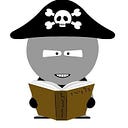Member-only story
Map Reading: Maps in Kids’ Books
Orienteering in Imaginative Space
“I don’t know if you have ever seen a map of a person’s mind. Doctors sometimes draw maps of other parts of you, and your own map can become intensely interesting, but catch them trying to draw a map of a child’s mind, which is not only confused, but keeps going round all the time. There are zigzag lines on it, just like your temperature on a card, and these are probably roads in the island; for the Neverland is always more or less and island, with astonishing splashes of colour here and there, and coral reefs and rakish-looking craft in the offing, and savages and lonely lairs, and gnomes who are mostly tailors, and caves through which a river runs, and princes with six elder brothers, and a hut fast going to decay, and one very small old lady with a hooked nose.”
— James Barrie, “Peter Pan”
I am a sucker for books with maps. I agree with Robert Louis Stevenson who said, “I am told there are people who do not care for maps, but I find it hard to believe.” Tell me about Peter Pan’s Neverland, and I want to know where the Mermaids’ Lagoon is in relation to Tiger Lily’s Camp. If the Emerald City is at the center of the Land of Oz, what lies to the north and the south?
A map is like the hypnotist’s pocket-watch swinging before my eyes. It is an invitation to…
